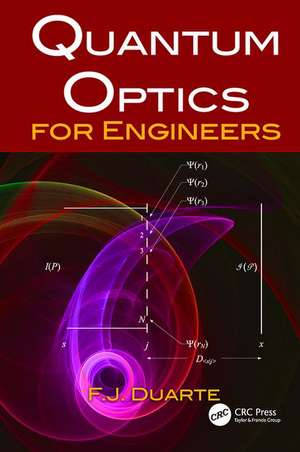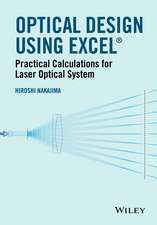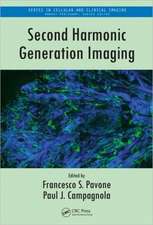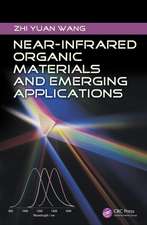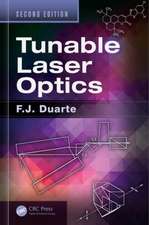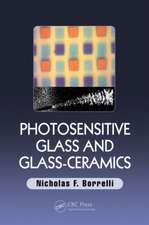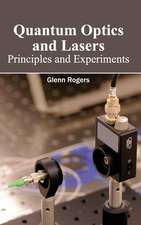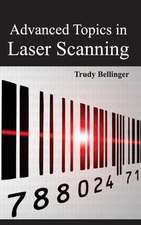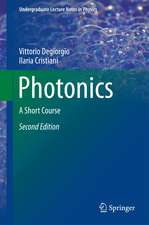Quantum Optics for Engineers
Autor F.J. Duarteen Limba Engleză Paperback – 29 mar 2017
Self-contained and using mainly first-year calculus and algebra tools, the book:
- Illustrates the interferometric quantum origin of fundamental optical principles such as diffraction, refraction, and reflection
- Provides a transparent introduction, via Dirac's notation, to the probability amplitude of quantum entanglement
- Explains applications of the probability amplitude of quantum entanglement to optical communications, quantum cryptography, quantum teleportation, and quantum computing.
| Toate formatele și edițiile | Preț | Express |
|---|---|---|
| Paperback (1) | 461.03 lei 6-8 săpt. | |
| CRC Press – 29 mar 2017 | 461.03 lei 6-8 săpt. | |
| Hardback (2) | 902.29 lei 6-8 săpt. | |
| CRC Press – 29 feb 2024 | 902.29 lei 6-8 săpt. | |
| CRC Press – 25 noi 2013 | 1119.45 lei 6-8 săpt. |
Preț: 461.03 lei
Preț vechi: 542.39 lei
-15% Nou
Puncte Express: 692
Preț estimativ în valută:
88.23€ • 91.77$ • 72.84£
88.23€ • 91.77$ • 72.84£
Carte tipărită la comandă
Livrare economică 14-28 aprilie
Preluare comenzi: 021 569.72.76
Specificații
ISBN-13: 9781138077546
ISBN-10: 1138077542
Pagini: 444
Ilustrații: 30 Tables, black and white; 189 Illustrations, black and white
Dimensiuni: 156 x 234 x 27 mm
Greutate: 0.45 kg
Ediția:1
Editura: CRC Press
Colecția CRC Press
ISBN-10: 1138077542
Pagini: 444
Ilustrații: 30 Tables, black and white; 189 Illustrations, black and white
Dimensiuni: 156 x 234 x 27 mm
Greutate: 0.45 kg
Ediția:1
Editura: CRC Press
Colecția CRC Press
Cuprins
Introduction. Planck’s Quantum Energy Equation. Uncertainty Principle. Dirac Quantum Optics. Interference, Diffraction, Refraction, and Reflection via the Dirac Notation. Generalized Multiple-Prism Dispersion. Dirac Notation Identities. Laser Excitation. Laser Oscillators Described via the Dirac Notation. Interferometry via the Dirac Notation. Secure Interferometric Communications in Free Space. Schrödinger’s Equation. Introduction to Feynman Path Integrals. Matrix Aspects of Quantum Mechanics. Classical Polarization. Quantum Polarization. Entangled Polarizations: Probability Amplitudes and Experimental Configurations. Quantum Computing. Quantum Cryptography and Teleportation. Quantum Measurements. Interpretational Issues in Quantum Mechanics.
Recenzii
"Duarte's book is a welcome addition to the family of optics texts because he stresses fundamental connections between classical and quantum optics. His review of the bedrock theory and experiments of several of the founders of quantum physics provides an instructive transition to recent developments in quantum optics, such as photon entanglement. Perhaps the most appealing aspect of this book is the treatment of classical optical concepts and phenomena in terms of a quantum formalism...Both graduate students and the experienced researcher will find this treatment of quantum optics to be illuminating and valuable...I look forward to having a copy in my personal library."
—Professor J. Gary Eden, Electrical and Computer Engineering, University of Illinois
"Quantum Optics for Engineers is an original and unique book that describes classical and quantum optical phenomena, and the synergy between these two subjects, from an interferometric perspective. Dirac’s notation is used ... [to] provide a lucid explanation of quantum polarization entanglement. The book will serve engineers with a minimum knowledge of quantum mechanics ... to understand modern experiments with lasers, optical communications, and the intriguing world of quantum entanglement."
––Ignacio E. Olivares, Universidad de Santiago de Chile
"Quantum Optics for Engineers provides a transparent and succinct description of the fundamentals of quantum optics using Dirac’s notation and ample illustrations. Particularly valuable is the explanation and elucidation of quantum entanglement from an interferometric perspective. The cohesiveness provided by the unified use of Dirac’s notation, emphasizing physics rather than mathematics, is particularly useful for those trained in engineering. This will be a valuable asset to any optical engineer’s library."
––Anne M. Miller, RR Donnelley, USA
"This book is a concise and comprehensive presentation of numerous fundamental concepts related to the light nature and its interaction with matter. A very structured and logical route reveals step by step the rigorous theory of quantum optics. To some extent, the whole project can be fairly defined as unique. One of the heaviest tools in quantum optics, operator representation, is introduced in a very clear and straightforward way. Nature foundations and rather complicated mathematical tools are brought in a very elegant manner such that readers suddenly find themselves as experts in areas they would consider untouchable magic. The intriguing world of quantum entanglement is revealed via many practical examples."
––Sergei Popov, Royal Institute of Technology, Sweden
—Professor J. Gary Eden, Electrical and Computer Engineering, University of Illinois
"Quantum Optics for Engineers is an original and unique book that describes classical and quantum optical phenomena, and the synergy between these two subjects, from an interferometric perspective. Dirac’s notation is used ... [to] provide a lucid explanation of quantum polarization entanglement. The book will serve engineers with a minimum knowledge of quantum mechanics ... to understand modern experiments with lasers, optical communications, and the intriguing world of quantum entanglement."
––Ignacio E. Olivares, Universidad de Santiago de Chile
"Quantum Optics for Engineers provides a transparent and succinct description of the fundamentals of quantum optics using Dirac’s notation and ample illustrations. Particularly valuable is the explanation and elucidation of quantum entanglement from an interferometric perspective. The cohesiveness provided by the unified use of Dirac’s notation, emphasizing physics rather than mathematics, is particularly useful for those trained in engineering. This will be a valuable asset to any optical engineer’s library."
––Anne M. Miller, RR Donnelley, USA
"This book is a concise and comprehensive presentation of numerous fundamental concepts related to the light nature and its interaction with matter. A very structured and logical route reveals step by step the rigorous theory of quantum optics. To some extent, the whole project can be fairly defined as unique. One of the heaviest tools in quantum optics, operator representation, is introduced in a very clear and straightforward way. Nature foundations and rather complicated mathematical tools are brought in a very elegant manner such that readers suddenly find themselves as experts in areas they would consider untouchable magic. The intriguing world of quantum entanglement is revealed via many practical examples."
––Sergei Popov, Royal Institute of Technology, Sweden
Descriere
This book is a concise and comprehensive presentation of numerous fundamental concepts related to the light nature and its interaction with matter. The Dirac approach is used in the description of optics, population inversion, laser gain, and polarization. The book provides insight into practical laser and quantum mechanics. It also explains the use of quantum mathematics which is required to understand the photon as it is used in real systems. Practical, real-world, worked-out examples are used throughout as well as interferometric calculations using MATLAB®.
Notă biografică
Francisco Javier "Frank" Duarte is a laser physicist and author/editor of several books on tunable lasers and quantum optics. His research on physical optics, quantum optics, and laser development has won several awards. He has made numerous original contributions to tunable lasers, multiple-prism optics, quantum interferometry, and quantum entanglement. Dr. Duarte was elected Fellow of the Australian Institute of Physics in 1987 and Fellow of the Optical Society (Optica) in 1993. He has received the Engineering Excellence Award (1995), for the invention of the N-slit laser interferometer, and the David Richardson Medal (2016) for his seminal contributions to the physics of narrow-linewidth tunable lasers and the theory of multiple-prism arrays for linewidth narrowing and laser pulse compression.
